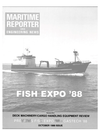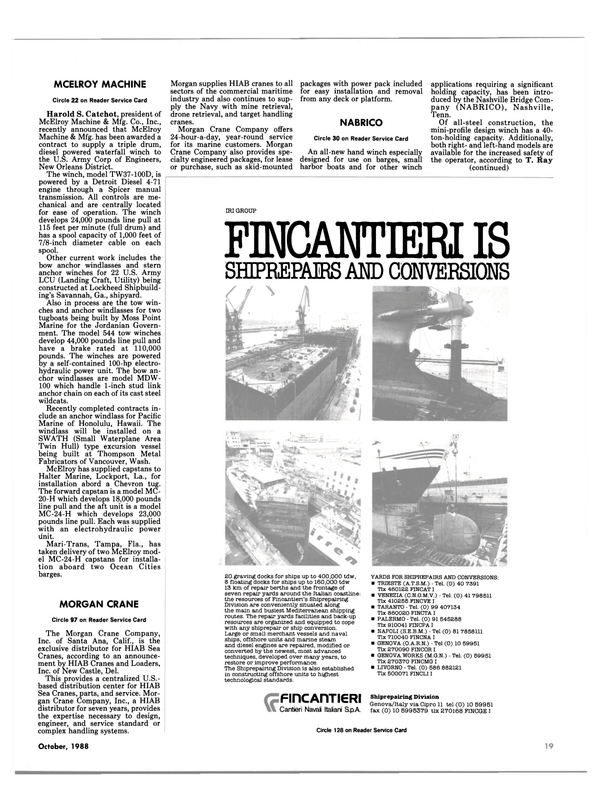
Upgraded MAN B&W L28/32 Engine Offers Improved Fuel Economy, Reliability And Durability
The merits of MAN B&W Holeby's L28/32 auxiliary engine series— one of the world's most popular heavy fuel-burning genset drives—have been enhanced by some recent significant design modifications.
The fuel economy has been substantially improved, and the reliability and durability of the new model promise to be even better than its market-leading predecessor.
The upgraded L28/32 is already in service or ordered for a number of prestigious auxiliary power installations.
Market response is reflected in an order backlog totaling 125,000 bhp at the Holeby factory as of June 1 this year, with deliveries scheduled well into the summer of 1990.
The upgraded engine retains the basic design of the well-proven 280 mm bore/320 mm stroke series but now exploits constant pressure turbocharging in conjunction with the new generation of high efficiency turbochargers. The system gives a simplified exhaust manifold and reduces charge air renewal work, boosting overall thermal efficiency and yielding a reduction in specific fuel consumption of 4-5 gr/bhph.
A major contribution to improved performance and reliability also stemmed from redesigning key engine components for a maximum firing pressure of up to 150 bar. Production engines, however, will still be released for operation at the original 130 bar rating. The resulting higher safety factor ensures low maintenance demands and extended durability from a design running well within its margins: a desirable feature not shared by some other engine designs, which are required to operate at or near their design limits.
Components benefiting from redesign include the cylinder head (still of high strength cast iron but with an improved stud securing arrangement to accept higher pressures), engine frame, cylinder liner, piston and connecting rod. The crankshaft was also modified and the bearing area increased by approximately 6 percent.
The improved combustion chamber created by the new cylinder head and piston crown contributed significantly to fuel economy gains.
Exhaust valve durability is enhanced by the higher thermal efficiency of the engine which yields valve temperatures some 50 degrees C lower than those of the original design.
The new L28/32 design supersedes the former '28 series' models in the streamlined MAN B&W Holeby GenSet program, which also embraces the '23 series' (L23/30 models). The upgraded 28 series is available in 5-, 6-, 7-, 8-, and 9-cylinder in-line versions to cover an output band from 1,190 to 2,570 bhp (875 to 1,890 kw) at 720 r/min for 60 Hz applications, and from 1,255 to 2,690 bhp (925 to 1,980 kw) at 750 r/min for 50 Hz applications.
The flexibility of the program is enhanced by MCR and ECR options already familiar on equivalent MAN B&W propulsion engines. The choice of an ECR output (about 80 percent of MCR) yields the minimum fuel consumption while retaining the capability to switch to MCR mode. Up to 30 percent spare capac- ity can thus be integrated at the newbuilding stage, ready for tapping to meet higher electricity load demands at any time during the ship's service life. The conversion is simply effected onboard by rematching the turbocharger and adjusting the valve gear.
Ships already benefiting from the new 28 series include the 3,900-TEU Marchen Maersk, the first of nine advanced containerships for A.P.
Moller. The auxiliary power package includes three 8-cylinder 28/32- based generating sets. Among the order backlog are 5-cylinder sets (20 in all) for six Del Monte reefer vessels booked from Astilleros Espanoles.
Improved engine design is complemented by recent investment in sophisticated flexible manufacturing systems at the Holeby factory to promote economic and efficient production.
For free literature giving full information on MAN B&W Holeby's upgraded L28/32 auxiliary engine series, Circle 43 on Reader Service Card
Read Upgraded MAN B&W L28/32 Engine Offers Improved Fuel Economy, Reliability And Durability in Pdf, Flash or Html5 edition of October 1988 Maritime Reporter
Other stories from October 1988 issue
Content
- Campbell Receives Order For Three 'Super Pacific' Tuna Purse Seiners page: 5
- Workboat Division Of MonArk Boat Changes Name To SeaArk Marine— Key Personnel Changes Announced page: 6
- Columbian Rope Co. Offers Free Literature Detailing New Fiber Rope For Marine Use page: 6
- Caterpillar-Powered Passenger Ferry Delivered By Moss Point Marine To State Of North Carolina page: 7
- General Ship Repair To Build Tender/Breaker Under $921,320 Contract page: 8
- Carnival Acquires Majority Of Admiral, RCCL For $550 Million page: 8
- P&O Purchases Sitmar Cruises For $210 Million page: 9
- Intertrade Awarded Navy Contract To Supply Messenger/Position Buoys page: 10
- HHI Wins $230-Million Offshore Project For ONGC In India page: 10
- Trinity Marine Group To Build Navy Oceanographic Research Ship page: 11
- Deck Machinery And Cargo-Handling Equipment page: 12
- FISH EXPO '88 page: 22
- Two More C-10 Containerships Delivered To APL By German Yards page: 26
- Okabe Offers Mil-Spec Fasteners Stocking And Mill Shipment Program page: 29
- G. Marine Diesel Leases Brooklyn Navy Yard Facilities page: 30
- Slaughter Joins Butterworth Tank Cleaning Machines page: 31
- World's Largest Monohull Crane Ship To Be Outfitted At McDermott Yard page: 34
- Bardex Views Contract Activity As Sign Of Offshore Improvement page: 35
- Cummins-Powered Crewboat Being Built At Matsumo Yard For Esso Resource Canada page: 36
- Matson Navigation Requests Bids From Three U.S. Shipyards To Build RO/RO Containership page: 37
- Advanced Deck Cranes From O&K Shorten Berthing Times, Cut Costs page: 38
- GASTECH 88 page: 40
- Fire-Damaged Crabber 'Reborn' After Conversion At MARCO-Seattle Yard page: 41
- 'Consolidation And Expansion' Will Be Theme Of Seatrade's Cruise Shipping '89 page: 42
- AESA Wins Orders From Cuba, Sweden; Will Build Seven Ships page: 43
- Free Literature Offered On High-Tech Multi-Pak Marine Trash Compactors page: 43
- Upgraded MAN B&W L28/32 Engine Offers Improved Fuel Economy, Reliability And Durability page: 44
- Unitor Offers Free 14-Page Brochure On Ship Services & Products page: 45
- New RAY-152 SSB Radiotelephone From Raytheon Provides Outstanding Long-Range Communication page: 46
- L'Orange Offers Free Literature On Engine Injector Systems page: 46
- Liquefied Gas Shipping— New Drewry Report Predicts Continued Improvement page: 47
- Rados-Designed Research And Monitoring Vessel Being Built By Knight & Carver In San Diego page: 48
- Rauma-Repola Deck Machinery And Aquamaster Propulsion Join Forces In New Company page: 48
- Golar Marine Incinerators Detailed In Free Literature page: 49
- Barco's '88-89 Catalog Of Impellers Includes 2 New Elastomer Cam/Pumpliners page: 49
- Trinity Marine Group Acquires Assets Of Guarino & Cox, Naval Architects page: 54
- Wartsila Diesel Announces Personnel Appointments page: 57
- HHI Wins Contract To Build LPG Carrier For Kosan Fleet Of Denmark page: 58


